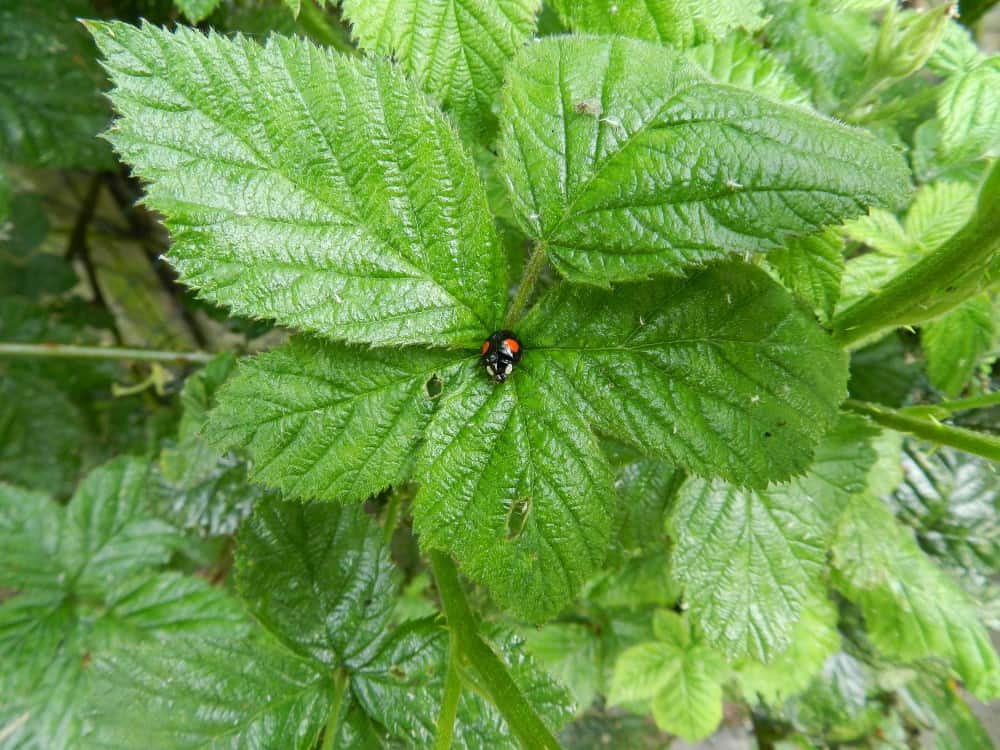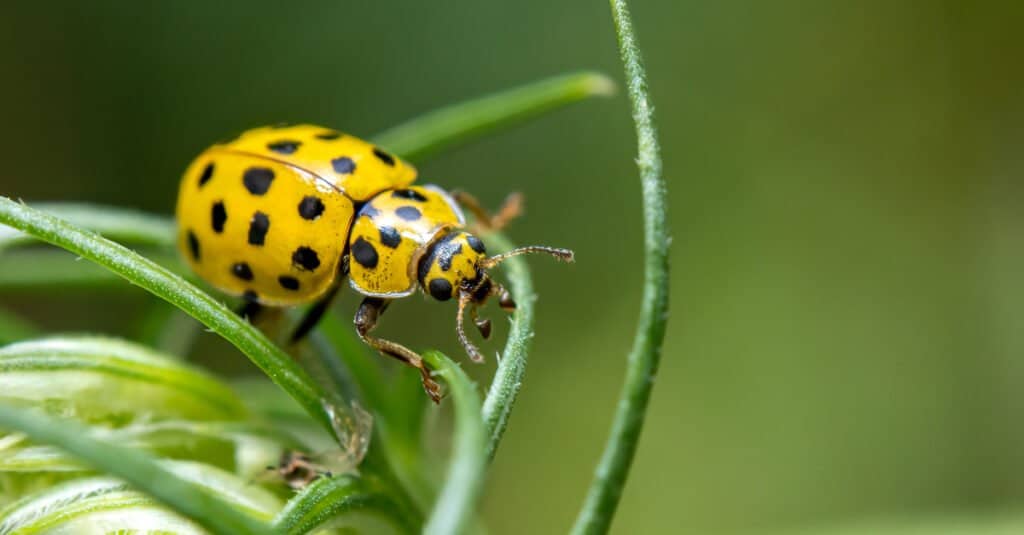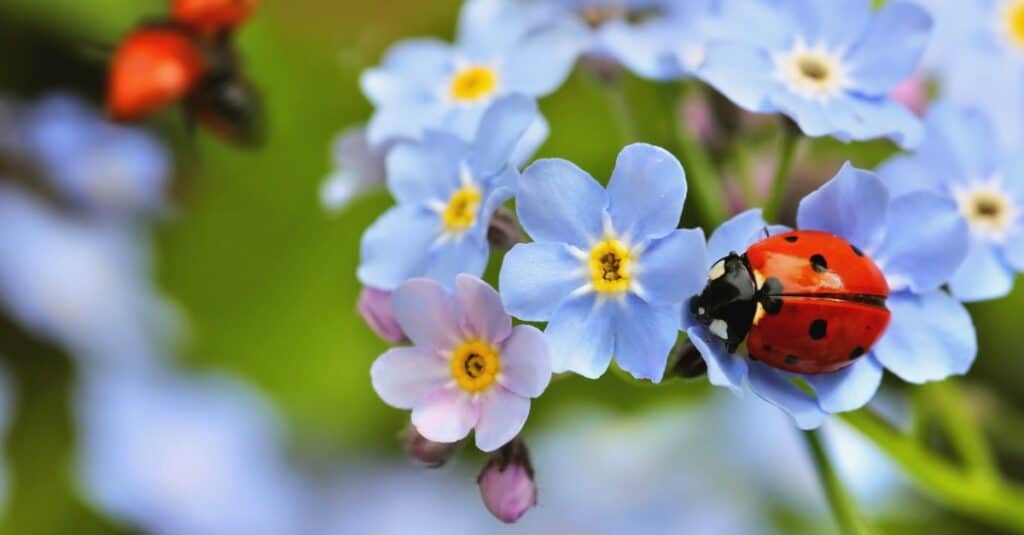Ladybugs are some of the most well-known and beloved “bugs” in the world. These tiny beetles are beautifully colored, graceful, and generally beneficial to crops and gardens. Many cultures associate ladybugs as symbols or messengers of good luck and happiness. According to Norse mythology, for example, ladybugs, or “Frejuhaend” (“Freyja’s Bird”) were sent by the goddess to aid humans. In Sanskrit, ladybugs are known as “Indragopa,” or “Indra’s shepherd”. In Christian tradition, ladybugs are associated with the Virgin Mary. Let’s take a closer look at these cute and curious insects with 10 incredible ladybug facts!
1. Ladybugs Are Not Actually Bugs

Guste L/Shutterstock.com
Turns out, a ladybug isn’t a bug at all—it is actually a type of beetle in the scientific order Coleoptera. Most scientists consider the term “Lady Beetle” to be the most accurate name for these little beetles, but they commonly referred to as ladybugs, ladybirds, and sometimes ladycows as well.
Ladybugs get their name from medieval farmers who believed they were a gift from the Virgin Mary. Farmers would pray to the Virgin Mary, or “Our Lady” and plead for help to get rid of the pests that were eating their crops. When these little spotted beetles showed up and ate all the pests, the farmers began to call them “beetles of Our Lady”.
Scientists and historians believe that it was the seven-spotted ladybug that came to the aid of these medieval farmers. Many people believed that the blood-red color of the ladybugs’ outer wings was a symbol of the Virgin Mary’s cloak, and its seven black spots were the seven sorrows of Mary.
2. Not All Ladybugs Are Red with Black Spots

Millie Bond – Copyright A-Z Animals
The most recognized ladybug is the seven-spotted ladybug of Europe and North America. Seven-spotted ladybugs are red or orangish-red, with three distinct black spots on each side of their bodies and one in the middle. In total, seven-spotted ladybugs have seven distinct spots, just like their name.
However, the iconic black and red seven-spotted ladybug is only one of the many variations of ladybugs out there. In fact, there are over 5,000 different species of ladybugs found all over the world! Different types of ladybugs have all kinds of colors and patterns, like orange, yellow, brown, black, ashy gray, and even a metallic steel blue. And then there’s the harlequin ladybug, which comes in many different colors, like black, red, and yellow, or even a mixture of multiple colors!
3. You Cannot Tell a Ladybug’s Age by its Spots

Millie Bond – Copyright A-Z Animals
You’ve probably heard the myth that you can tell how old a ladybug is by counting the spots on its back. Turns out, it doesn’t really work that way. Instead, each ladybug species not only comes in many different colors, but individually unique patterns as well. Many ladybug species do have the iconic spots that ladybugs are known for, but others instead have squiggles or stripes. There are even some ladybugs that have no patterns at all!
The color and pattern of a ladybug may not be able to tell you how old it is, but it can help you determine which species of ladybug it is. As previously mentioned, the seven-spotted ladybug is red with seven black spots on its back (three on each red wing, and one in the center). The twice-stabbed ladybug, on the other hand, is black with two large red spots (one on each wing). The twenty-two spot Ladybird is bright yellow with twenty-two black spots.
Then there’s that pesky harlequin ladybug again. In some areas this ladybug is called the “halloween beetle”, because it is always sporting a different look. Not only does it come in a variety of colors, but it can also have anywhere between zero to twenty-two spots!
4. Ladybugs Are Colorful Because They Taste Bad

marcinswiostek/Shutterstock.com
When a ladybug feels threatened, it secretes an oily yellow fluid called hemolymph that has a very offensive taste. This makes ladybugs very unappetizing to predators. This applies to humans as well. For example, harlequin ladybugs are often accidentally harvested along with grapes in vineyards. If the ladybugs are not removed, their defensive toxins can get into the wine and destroy its flavor.
In addition to their foul-tasting hemolymph, ladybugs also sport bright colors with contrasting patterns to prevent predators from being tempted to try a taste. Scientists call these “aposematic” colors because they warn potential predators that ladybugs taste really bad.
5. Ladybugs Eat a Lot

iStock.com/Henrik_L
Many ladybug species primarily eat aphids as their main food source. Aphids are tiny insects that bite plants and slurp up their juices and sap. Unfortunately, this stunts the growth of the plants. However, ladybugs love aphids, which makes them a farmer’s best friend.
Today ladybugs are often introduced to agricultural areas as a natural form of biological control for aphids and other pests. This in turn helps farmers to produce more crops. For example, the iconic seven-spotted ladybug was originally native to Europe. However, in the mid-1900’s it was brought over to North America to help regulate aphid populations. A single ladybug can eat up to 5,000 insects by the end of its life! However, introducing ladybugs to a new area can also be harmful to other native insects that must compete with the new residents for food.
6. Ladybugs Intentionally Lay Both Fertile and Infertile Eggs
Ladybugs try to lay their eggs near abundant food sources, such as the underside of a leaf with lots of aphids. The bright yellow egg clusters, however, contain both fertile and infertile eggs. This is not an accident or mistake made by a ladybug parent. Ladybugs lay infertile eggs alongside fertile eggs to provide an extra food source for the next generation. Within a week or so, the small ladybug larvae hatch and can immediately begin munching on the nutritious infertile eggs!
7. Ladybug Larvae Look Menacing
Ladybug larvae do not really look like their adorable adult counterparts. In fact, if you saw one of these menacing looking larva, you probably would not instantly think, “Oh cute, a ladybug baby!”. That is because when ladybugs are still in their larval stage of life, they look more like crocodilian caterpillars with long bodies covered in spikes or bumps.
Like adult ladybugs, however, ladybug larvae are also brightly colored with bold patterns. Vibrant colors of orange, yellow, and red, help to ward off any potential predators that may try to eat the young larvae.
8. Ladybugs Hibernate

Marek Mierzejewski/Shutterstock.com
As they grow and develop, ladybug larvae shed several times before attaching to a leaf, forming their bodies into a pupa. After 1-2 weeks, a newly formed adult ladybug emerges, ready to take on the world.
Adult ladybugs are active during the warmer months of spring, summer, and fall. When the weather turns cold, however, they gather together in large groups to hibernate. Ladybugs typically hibernate in warm, protected areas like behind bark, under leaves or rocks, in rotting logs, and even in houses. A single group or colony of hibernating ladybugs could include thousands of ladybugs at a time!
9. Ladybugs Live All Over the World
Scientists consider ladybugs to be a “cosmopolitan group”, which means that they can live just about anywhere besides extreme climates like Antarctica. Ladybugs live in forests, along rivers, in grasslands, and even in cities and suburbs. If there is enough food to go around, a ladybug can easily find a place to live in comfort.
10. Ladybugs Have Two Sets of Wings—But Only One Can Fly

If you look at a ladybug, it does not look like it was really meant to fly. These colorful little beetles have tiny, round bodies covered by a domed shell, which is not the most aerodynamic design. The two hard-shelled wings covering their backs serve more as a protective armor, rather than a flying apparatus.
However, these modified armor-like wings protect a second set of more delicate flight wings. These lighter wings fold perfectly beneath the ladybug’s armored shield. When a ladybug is ready to take flight, it lifts its colorful, hard outer wings and unfolds the slender flight wings beneath.
The post 10 Incredible Ladybug Facts appeared first on AZ Animals.
from Animal News, Facts, Rankings, and More! - AZ Animals https://ift.tt/Fe5W9US


 (@MushyStuff__)
(@MushyStuff__)